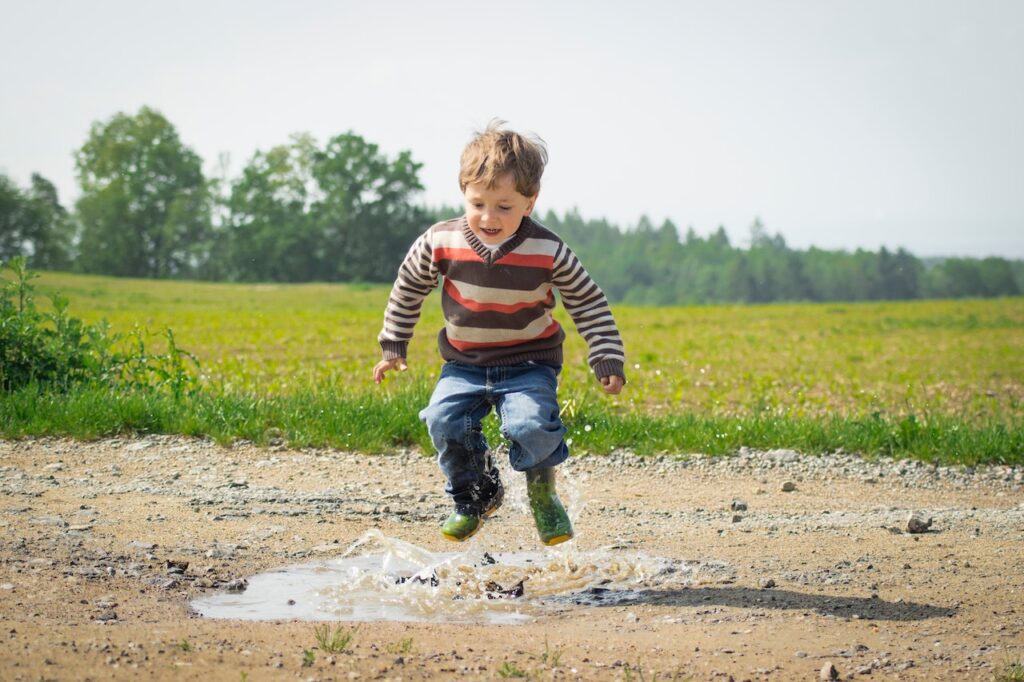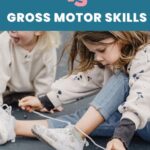A Parents Guide to the Difference Between Fine and Gross Motor Skills
Humans rely on motor skills to carry out everyday tasks, from brushing their teeth to playing sports. Motor skills refer to the ability to control and coordinate our movements, and they can be divided into two categories: fine motor skills and gross motor skills.
Play. Learn. Thrive.™ only endorses products we authentically love and use. Some of the product links in this post may be affiliate links. That means that if you click them and make a purchase, this site makes a commission. Play. Learn. Thrive.™ is also an Amazon Associate. As an Amazon Associate, we earn from qualifying purchases. It will have no impact on the price you pay or the experience of your purchase.
As parents, it's a good idea to understand what these skills look like in real life so we can best support our children's development and ensure they are hitting their developmental milestones.

The difference between fine and gross motor skills.
What are fine motor skills?
Fine motor skills involve using smaller muscles, such as those in the hands and fingers, to perform small movements. These skills require a high degree of precision and coordination. Examples of fine motor skills include writing, doing buttons, using scissors, tying shoelaces, using utensils to eat, or zipping a zipper.
What are gross motor skills?
On the other hand, gross motor skills involve using large muscles. These large muscle groups, such as those in the arms, legs, and torso, perform more general and less precise movements. These skills involve coordinating multiple body parts and are essential for activities requiring strength, endurance, and balance. Examples of gross motor skills include crawling, walking, running, jumping, throwing, and climbing.
One way to remember the difference between fine and gross motor skills is to consider them “big” versus “small” movements. Fine motor skills involve smaller, more precise movements, while gross motor skills involve larger, more general movements.
Examples of fine and gross motor skills
Remember that these are all fine and gross motor skills your child will eventually learn and that all children develop at different rates. Learning these skills won't happen overnight, and some children may struggle to master any number of these depending on their motor skill abilities. If you have concerns about your child's development of motor skills, it's best to speak with your child's doctor sooner rather than later.

20 everyday activities for fine motor skill development
- Grasping and releasing objects
- Picking up small objects with the fingertips
- Using utensils to eat
- Turning pages in a book
- Buttoning and unbuttoning clothes
- Using scissors to cut paper
- Drawing and coloring
- Writing or tracing letters and numbers
- Tying shoelaces
- Using a keyboard or mouse on a computer
- Playing musical instruments
- Putting together jigsaw puzzles
- Using a screwdriver or small tools
- Sewing or knitting
- Playing games that require fine motor skills
- Zipping up a jacket or backpack
- Applying makeup or grooming hair
- Opening and closing containers with twist-off or snap-on lids
- Using tools like grooming tools like tweezers or nailclippers.
- Playing with playdough or clay

20 gross motor activities that involve the entire body
- Sitting
- Pulling to stand
- Walking
- Running
- Jumping
- Hopping
- Skipping
- Climbing (we love a pikler triangle for encouraging this)
- Kicking a ball
- Catching a ball
- Throwing a ball
- Riding a bike, roller-skating, rollerblading, scootering or skateboarding
- Dancing
- Swimming
- Playing on playground equipment, such as swings or slides
- Balancing on one foot
- Doing jumping jacks or other exercises that require coordination
- Doing yoga or other physical activities that require balance
- Carrying heavy objects, like backpacks or groceries
- Doing obstacle courses or other physical challenges.
Are fine motor skills or gross motor skills more important?
Simple answer. They are both important but for different reasons!
Fine and gross motor skills are important for overall physical and cognitive development.
Fine motor skills are essential for activities requiring dexterity and precision, from dressing to playing a musical instrument or performing surgery. Gross motor skills are essential for physical activities and larger movements that require strength, endurance, and balance like walking, running, and playing sports.
So while fine and gross motor skills are distinct categories, they work together to enable us to perform various activities in our daily lives. Developing and maintaining strong motor skills is essential for overall health and well-being.

Do boys and girls differ in their motor skill development?
Yes AND no. Let's talk more about this.
Boys and girls can differ in their motor skill development, although individual differences between sexes are often more significant than differences between sexes.
Generally speaking, boys tend to have an advantage in developing gross motor skills, while girls tend to have an advantage in developing fine motor skills.
For example, research has shown that boys tend to have greater upper body strength, which can help them excel in throwing and catching balls, climbing, and jumping. Typically boys develop gross motor control faster than fine motor skills. On the other hand, girls tend to have better fine motor skills (which they develop faster), which can help them excel in activities such as drawing, writing, and manipulating small objects.
However, it's important to note that these differences are not absolute! For example, plenty of girls excel in gross motor skills, such as sports, and plenty of boys excel in fine motor skills, such as art.
It's also important to note that differences in motor skill development may be influenced by cultural factors, such as the types of activities boys and girls are encouraged to participate. This a prime example of how nurture impacts development.
For example, suppose boys are encouraged to participate in sports and physical activities from a young age. In that case, they may develop better gross motor skills than being innately “better” at gross motor activities than girls.
While there may be some differences in motor skill development, these differences are not absolute and should not be used to limit or stereotype children based on their sex. I
Our goal should be to encourage our children to participate in various activities that promote the development of fine and gross motor skills, regardless of their sex.
At what age do children start developing fine motor skills?
Children start developing new skills from birth, but the development of these small muscles varies depending on the child's individual growth and development.
Generally, infants will begin to develop fine motor skills through their exploration of their environment and their own bodies. They will begin to reach for and grasp objects, start to develop a pincer grasp and learn to control their hand movements.
Around 1-2 years of age, children typically develop more refined fine motor skills, such as manipulating small objects, stacking blocks, and using utensils to feed themselves. By age 3, most young children have developed good eye-hand coordination and can more accurately manipulate small objects with pretty precise fine motor movements.
It's important to note that every child develops at their own pace, and some children may develop these skills earlier or later than others. It's also important to provide opportunities for children to practice and refine their fine motor skills through play, exploration, and age-appropriate activities.
At what age do children start developing gross motor skills?
Children also begin gross motor development from birth. The child's motor skills development will vary depending on the child's ability and environmental factors.
During the first few months of life, infants develop gross motor skills by lifting and turning their heads, rolling over, and sitting up independently. As they grow and develop, they will begin hitting bigger gross motor skill milestones like crawling, pulling themselves up to stand, and eventually walking.
By age 2, most children can walk and run with some coordination. They can climb stairs, jump, throw, and catch a ball.
Children between the ages of 3 and 5 continue to refine these large movements and develop more advanced abilities and physical strength. They begin to hit physical milestones such as riding a tricycle, hopping on one foot, and skipping.
Again, it's important to note that every child develops at their own pace, and some children may develop these skills earlier or later than others. Providing opportunities for children to practice and develop their gross motor skills through play and physical activity is important for their overall development and health.
How does motor skills development impact learning?
Fine and gross motor skills are essential for a child's overall development and can significantly impact their learning abilities.
Here are some ways in which the development of fine and gross motor skills can impact a child's learning:
- Improved hand-eye coordination: Both fine and gross motor skills require hand-eye coordination, which is the ability to coordinate the movements of the hands and eyes to perform a task. This skill is crucial for reading, writing, and playing sports.
- Better academic performance: Fine motor skills are essential for academic tasks such as writing, drawing, and using scissors. Children with well-developed fine motor skills can complete these tasks more easily and accurately, improving their academic performance.
- Improved social skills: Gross motor skills play a role in developing social skills, such as teamwork and cooperation. For example, children who play team sports learn to work together, communicate effectively, and share resources.
- Increased confidence: Children with well-developed motor skills are more likely to feel confident in their abilities. This can have a positive impact on their learning and overall well-being.
- Enhanced problem-solving skills: Both fine and gross motor skills require problem-solving abilities. For example, when children are learning to tie their shoes or use scissors, they must figure out how to coordinate their movements to achieve the desired outcome.
The development of both fine and gross motor skills can have a significant impact on a child's learning. Parents (and teachers) can help children reach their full potential and succeed in academic and social contexts by providing opportunities to develop these skills.
The development of both fine and gross motor skills can have a significant impact on a child's learning. Parents (and teachers) can help children reach their full potential and succeed in academic and social contexts by providing opportunities to develop these skills.

